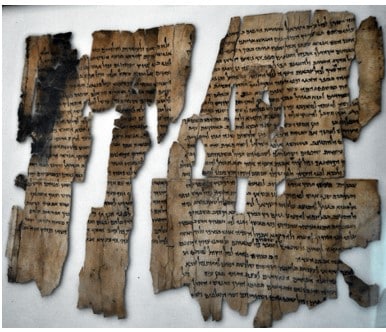The New Testament is constantly under attack, and its reliability and accuracy are often contested by critics. But, there is ample manuscript evidence for superior New Testament reliability over all other ancient documents. If the critics want to disregard the New Testament, then they must also disregard other ancient writings by Plato, Aristotle, and Homer. This is because the New Testament documents are better preserved and more numerous than any other ancient writings. Because they are so numerous, they can be cross-checked for accuracy . . . and they are very consistent.
There are presently 5,686 Greek manuscripts in existence today for the New Testament.1 If we were to compare the number of New Testament manuscripts to other ancient writings, we find that the New Testament manuscripts far outweigh the others in quantity.2
| Author | Date Written |
Earliest Copy | Approximate Time Span between original & copy | Number of Copies | Accuracy of Copies |
| Lucretius | died 55 or 53 B.C. | 1100 yrs | 2 | —- | |
| Pliny | A.D. 61-113 | A.D. 850 | 750 yrs | 7 | —- |
| Plato | 427-347 B.C. | A.D. 900 | 1200 yrs | 7 | —- |
| Demosthenes | 4th Cent. B.C. | A.D. 1100 | 800 yrs | 8 | —- |
| Herodotus | 480-425 B.C. | A.D. 900 | 1300 yrs | 8 | —- |
| Suetonius | A.D. 75-160 | A.D. 950 | 800 yrs | 8 | —- |
| Thucydides | 460-400 B.C. | A.D. 900 | 1300 yrs | 8 | —- |
| Euripides | 480-406 B.C. | A.D. 1100 | 1300 yrs | 9 | —- |
| Aristophanes | 450-385 B.C. | A.D. 900 | 1200 | 10 | —- |
| Caesar | 100-44 B.C. | A.D. 900 | 1000 | 10 | —- |
| Livy | 59 BC-AD 17 | —- | ??? | 20 | —- |
| Tacitus | circa A.D. 100 | A.D. 1100 | 1000 yrs | 20 | —- |
| Aristotle | 384-322 B.C. | A.D. 1100 | 1400 | 49 | —- |
| Sophocles | 496-406 B.C. | A.D. 1000 | 1400 yrs | 193 | —- |
| Homer (Iliad) | 900 B.C. | 400 B.C. | 500 yrs | 643 | 95% |
| New Testament |
1st Cent. A.D. (A.D. 50-100) | 2nd Cent. A.D. (c. A.D. 130 f.) |
less than 100 years | 5600 | 99.5% |
As you can see, there are thousands more New Testament Greek manuscripts than any other ancient writing. The internal consistency of the New Testament documents is about 99.5% textually pure. That is an amazing accuracy. In addition, there are over 19,000 copies in the Syriac, Latin, Coptic, and Aramaic languages. The total supporting New Testament manuscript base is over 24,000.
Almost all biblical scholars agree that the New Testament documents were all written before the close of the First Century. If Jesus was crucified in A.D. 30., then that means the entire New Testament was completed within 70 years. This is important because it means there were plenty of people around when the New Testament documents were penned–people who could have contested the writings. In other words, those who wrote the documents knew that if they were inaccurate, plenty of people would have pointed it out. But, we have absolutely no ancient documents contemporary with the First Century that contest the New Testament texts.
Furthermore, another important aspect of this discussion is the fact that we have a fragment of the gospel of John that dates back to around 29 years from the original writing (John Rylands Papyri A.D. 125). This is extremely close to the original writing date. This is simply unheard of in any other ancient writing, and it demonstrates that the Gospel of John is a First Century document.
Below is a chart with some of the oldest extant New Testament manuscripts compared to when they were originally penned. Compare these time spans with the next closest, which is Homer’s Iliad, where the closest copy from the original is 500 years later. Undoubtedly, that period of time allows for more textual corruption in its transmission. How much less so for the New Testament documents?
| Important Manuscript Papyri |
Contents | Date Original Written |
MSS Date |
Approx. Time Span |
Location |
| p52 (John Rylands Fragment)3 |
John 18:31-33, 37-38 | circa A.D. 96 |
circa A.D. 125 |
29 yrs | John Rylands Library, Manchester, England |
| P46 (Chester Beatty Papyrus) |
Rom. 5:17-6:3, 5-14; 8:15-25, 27-35; 10:1-11, 22, 24-33, 35; 16:1-23, 25-27; Heb.; 1 & 2 Cor., Eph., Gal., Phil., Col.; 1 Thess. 1:1, 9-10; 2:1-3; 5:5-9, 23-28 | ’50s-’70s | circa A.D. 200 |
Approx. 150 yrs |
Chester Beatty Museum, Dublin & Ann Arbor, Michigan, University of Michigan library |
| P66 (Bodmer Papyrus) |
John 1:1-6:11, 35-14:26; fragment of 14:29-21:9 | 70’s | circa A.D. 200 |
Approx. 130 yrs |
Cologne, Geneva |
| P67 | Matt. 3:9,15; 5:20-22, 25-28 | circa A.D. 200 |
Approx. 130 yrs |
Barcelona, Fundacion San Lucas Evangelista, P. Barc.1 |
If the critics of the Bible dismiss the New Testament as reliable information, then they must also dismiss the reliability of the writings of Plato, Aristotle, Caesar, Homer, and the other authors mentioned in the chart at the beginning of the paper. On the other hand, if the critics acknowledge the historicity and writings of those other individuals, then they must also retain the historicity and writings of the New Testament authors; after all, the evidence for the New Testament’s reliability is far greater than the others. The Christian has substantially superior criteria for affirming the New Testament documents than he does for any other ancient writing. It is good evidence on which to base the trust in the reliability of the New Testament.
References
| 1↑ | Norman Geisler & Peter Bocchino, Unshakeable Foundations, (Minneapolis, MN: Bethany House Publishers, 2001) p. 256. |
|---|---|
| 2↑ | The above chart was adapted from three sources: 1) Christian Apologetics, by Norman Geisler, 1976, p. 307; 2) the article “Archaeology and History attest to the Reliability of the Bible,” by Richard M. Fales, Ph.D., in The Evidence Bible, Compiled by Ray Comfort, Bridge-Logos Publishers, Gainesville, FL, 2001, p. 163; and 3) A Ready Defense, by Josh Mcdowell, 1993, p. 45. |
| 3↑ | “Deissmann was convinced that p52 was written well within the reign of Hadrian (A.D. 117-38) and perhaps even during the time of Trajan (A.D. 98-117)” (Footnote #2 found on pg. 39 of The Text of the New Testament, by Bruce M. Metzger, 2nd Ed. 1968, Oxford University Press, NY, NY). Bruce Metzger has authored more than 50 books. He holds two Masters Degrees, a Ph.D., and has been awarded several honorary doctorates. “He is past president of the Society of Biblical Literature, the International Society for New Testament Studies, and the North American Patristic Society.” — From, The Case for Christ, by Lee Strobel, Zondervan Publishers, 1998, Grand Rapids, MI: pg. 57. |






